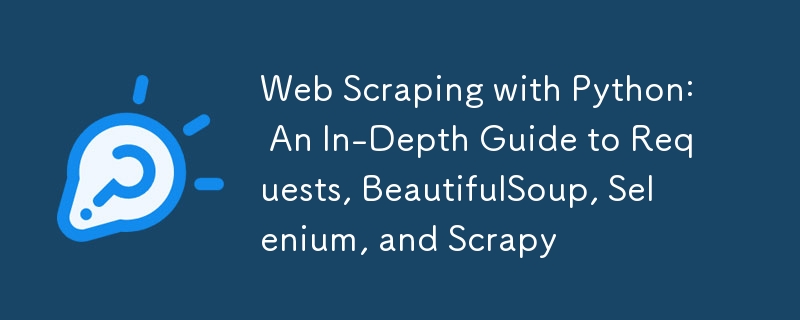使用 Python 進行網頁抓取:Requests、BeautifulSoup、Selenium 和 Scrapy 的深入指南
- 王林原創
- 2024-08-23 06:02:351084瀏覽

網頁抓取是一種用於從網站提取資訊的方法。它可以成為數據分析、研究和自動化的寶貴工具。 Python 擁有豐富的函式庫生態系統,為網頁抓取提供了多種選項。在本文中,我們將探討四個流行的函式庫:Requests、BeautifulSoup、Selenium 和 Scrapy。我們將比較它們的功能,提供詳細的程式碼範例,並討論最佳實踐。
目錄
- 網頁抓取簡介
- 請求庫
- BeautifulSoup 庫
- 硒庫
- Scrapy 框架
- 庫比較
- 網頁抓取的最佳實務
- 結論
網頁抓取簡介
網頁抓取涉及取得網頁並從中提取有用的資料。它可用於多種目的,包括:
- 研究資料收集
- 電子商務價格監控
- 來自多個來源的內容聚合
法律和道德考慮
在抓取任何網站之前,檢查該網站的 robots.txt 檔案和服務條款以確保遵守其抓取政策至關重要。
請求庫
概述
Requests 函式庫是一種在 Python 中發送 HTTP 請求的簡單且使用者友善的方法。它抽象化了 HTTP 的許多複雜性,使得取得網頁變得容易。
安裝
您可以使用 pip 安裝 Requests:
pip install requests
基本用法
以下是如何使用請求來取得網頁:
import requests
url = 'https://example.com'
response = requests.get(url)
if response.status_code == 200:
print("Page fetched successfully!")
print(response.text) # Prints the HTML content of the page
else:
print(f"Failed to retrieve the webpage: {response.status_code}")
處理參數和標頭
您可以使用請求輕鬆傳遞參數和標頭:
params = {'q': 'web scraping', 'page': 1}
headers = {'User-Agent': 'Mozilla/5.0'}
response = requests.get(url, params=params, headers=headers)
print(response.url) # Displays the full URL with parameters
處理會話
Requests 也支援會話管理,這對於維護 cookie 很有用:
session = requests.Session()
session.get('https://example.com/login', headers=headers)
response = session.get('https://example.com/dashboard')
print(response.text)
美麗湯圖書館
概述
BeautifulSoup 是一個用於解析 HTML 和 XML 文件的強大函式庫。它與從網頁中提取資料的請求配合良好。
安裝
您可以使用 pip 安裝 BeautifulSoup:
pip install beautifulsoup4
基本用法
以下是如何使用 BeautifulSoup 解析 HTML:
from bs4 import BeautifulSoup
html_content = response.text
soup = BeautifulSoup(html_content, 'html.parser')
# Extracting the title of the page
title = soup.title.string
print(f"Page Title: {title}")
導航解析樹
BeautifulSoup 讓您輕鬆導航解析樹:
# Find all <h1> tags
h1_tags = soup.find_all('h1')
for tag in h1_tags:
print(tag.text)
# Find the first <a> tag
first_link = soup.find('a')
print(first_link['href']) # Prints the URL of the first link
使用 CSS 選擇器
您也可以使用 CSS 選擇器來尋找元素:
# Find elements with a specific class
items = soup.select('.item-class')
for item in items:
print(item.text)
硒庫
概述
Selenium 主要用於自動化 Web 應用程式以進行測試,但對於抓取由 JavaScript 呈現的動態內容也很有效。
安裝
您可以使用 pip 安裝 Selenium:
pip install selenium
設定網路驅動程式
Selenium 需要您想要自動化的瀏覽器的 Web 驅動程式(例如,用於 Chrome 的 ChromeDriver)。確保您已安裝驅動程式並在您的 PATH 中可用。
基本用法
以下是如何使用 Selenium 取得網頁:
from selenium import webdriver
# Set up the Chrome WebDriver
driver = webdriver.Chrome()
# Open a webpage
driver.get('https://example.com')
# Extract the page title
print(driver.title)
# Close the browser
driver.quit()
與元素交互
Selenium 允許您與 Web 元素進行交互,例如填寫表單和點擊按鈕:
# Find an input field and enter text
search_box = driver.find_element_by_name('q')
search_box.send_keys('web scraping')
# Submit the form
search_box.submit()
# Wait for results to load and extract them
results = driver.find_elements_by_css_selector('.result-class')
for result in results:
print(result.text)
處理動態內容
Selenium 可以等待元素動態載入:
from selenium.webdriver.common.by import By
from selenium.webdriver.support.ui import WebDriverWait
from selenium.webdriver.support import expected_conditions as EC
# Wait for an element to become visible
try:
element = WebDriverWait(driver, 10).until(
EC.visibility_of_element_located((By.ID, 'dynamic-element-id'))
)
print(element.text)
finally:
driver.quit()
Scrapy框架
概述
Scrapy 是一個強大且靈活的網頁抓取框架,專為大規模抓取專案而設計。它為處理請求、解析和儲存資料提供內建支援。
安裝
您可以使用pip安裝Scrapy:
pip install scrapy
建立一個新的 Scrapy 項目
要建立新的 Scrapy 項目,請在終端機中執行以下命令:
scrapy startproject myproject cd myproject scrapy genspider example example.com
基本蜘蛛範例
這是一個從網站抓取資料的簡單蜘蛛:
# In myproject/spiders/example.py
import scrapy
class ExampleSpider(scrapy.Spider):
name = 'example'
start_urls = ['https://example.com']
def parse(self, response):
# Extract data using CSS selectors
titles = response.css('h1::text').getall()
for title in titles:
yield {'title': title}
# Follow pagination links
next_page = response.css('a.next::attr(href)').get()
if next_page:
yield response.follow(next_page, self.parse)
運行蜘蛛
您可以從命令列運行蜘蛛:
scrapy crawl example -o output.json
此指令會將抓取的資料儲存到output.json。
專案管道
Scrapy 允許您使用專案管道處理抓取的資料。您可以有效率地清理和儲存資料:
# In myproject/pipelines.py
class MyPipeline:
def process_item(self, item, spider):
item['title'] = item['title'].strip() # Clean the title
return item
配置設定
您可以在settings.py中配置設定來自訂您的Scrapy專案:
# Enable item pipelines
ITEM_PIPELINES = {
'myproject.pipelines.MyPipeline': 300,
}
Comparison of Libraries
| Feature | Requests + BeautifulSoup | Selenium | Scrapy |
|---|---|---|---|
| Ease of Use | High | Moderate | Moderate |
| Dynamic Content | No | Yes | Yes (with middleware) |
| Speed | Fast | Slow | Fast |
| Asynchronous | No | No | Yes |
| Built-in Parsing | No | No | Yes |
| Session Handling | Yes | Yes | Yes |
| Community Support | Strong | Strong | Very Strong |
Best Practices for Web Scraping
Respect Robots.txt: Always check the robots.txt file of the website to see what is allowed to be scraped.
Rate Limiting: Implement delays between requests to avoid overwhelming the server. Use time.sleep() or Scrapy's built-in settings.
User-Agent Rotation: Use different User-Agent strings to mimic different browsers and avoid being blocked.
Handle Errors Gracefully: Implement error handling to manage HTTP errors and exceptions during scraping.
Data Cleaning: Clean and validate the scraped data before using it for analysis.
Monitor Your Scrapers: Keep an eye on your scrapers to ensure they are running smoothly and efficiently.
Conclusion
Web scraping is a powerful tool for gathering data from the web. Choosing the right library or framework depends on your specific needs:
- Requests + BeautifulSoup is ideal for simple scraping tasks.
- Selenium is perfect for dynamic content that requires interaction.
- Scrapy is best suited for large-scale scraping projects that require efficiency and organization.
By following best practices and understanding the strengths of each tool, you can effectively scrape data while respecting the web ecosystem. Happy scraping!
以上是使用 Python 進行網頁抓取:Requests、BeautifulSoup、Selenium 和 Scrapy 的深入指南的詳細內容。更多資訊請關注PHP中文網其他相關文章!

